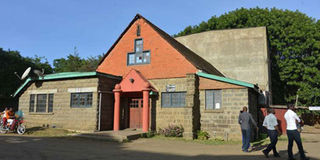Breaking News: KDF chopper crash kills five
Mixed reactions as county reveals plan to renovate theatre

The Nakuru Players Theatre that has preserved the chairs, tables, props and costumes used on stage by the first set of thespians at the theatre, who were mainly white settlers. PHOTO | FILE
What you need to know:
- The building was originally a Masonic Lodge and was purchased in 1954 by colonial settlers, with funds from donations from the community, and converted into a theatre.
- The theatre has preserved old props used in stage performances, minutes recorded during theatre sessions, photographs and enormous volumes of costumes.
- Some thespians have called for the construction of a modern theatre complex without destroying the old theatre house. They want it preserved as a museum of contemporary art.
Plans by the Nakuru County government to renovate the Nakuru Players Theatre have elicited mixed reactions from the town’s thespians. While some have welcomed the move, others strongly feel the old colonial building should retain as much of its historical feel as possible.
The county government has pledged to spend Sh40 million this financial year to refurbish and modernise the facility, a move that could see most of the old equipment discarded and the hall expanded.
Lighting and sound equipment at the theatre are outdated and will have to be replaced.
The Nakuru Players Theatre is one of the oldest buildings in the country. It holds crucial information on how colonial settlers lived and spent their leisure time in the 1930s.
The building was originally a Masonic Lodge and was purchased in 1954 by colonial settlers, with funds from donations from the community, and converted into a theatre.
“The donors included such well known settlers as Lord Egerton and Lord Delamere,” says Michael Kamunya, an accomplished thespian and theatre director.
MUSEUM OF ART
Kamunya says many theatre goers had come to like the old theatre house that has a high roof, a raised podium complete with a pianist’s cubicle strategically located not to obstruct the audience’s view.
The theatre has preserved old props used in stage performances, minutes recorded during theatre sessions, photographs and enormous volumes of costumes.
The photographs have ensured continuity as young thespians and directors can trace changes in production techniques over the years.
The black and white photographs, dating from the 1930s, tell the story of Nakuru’s theatre life that used to attract noble families from as far as England.
The building retains its ancient lighting system that includes floodlights, barten lights and spotlights.
Some thespians have called for the construction of a modern theatre complex without destroying the old theatre house. They want it preserved as a museum of contemporary art.
The theatre has preserved the chairs, tables, props and costumes used on stage by the first set of thespians at the theatre, who were mainly white settlers.
Nakuru Players’ theatre chairman Francis Gachau says the new theatre complex will create more space for conferences and meetings.
“We have space next to the old theatre that can be used to set up a modern theatre,” said Mr Gachau.
“Many changes have occurred in theatre as technology has evolved and replaced the one-on-one traditional performance and its audience to the digital era,” says Lydia Abukhatsi, a theatre producer, actress and teacher.





